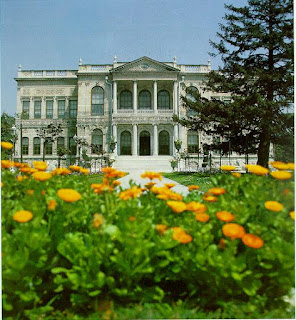 The Dolmabahce Palace, a blend of various European architectural styles, was built between 1843-1856 by Karabet Balyan, the court architect of Sultan Abdulmecid. The Ottoman sultans had many palaces in all ages, but the Topkapi was the official residence until the completion of the Dolmabahce Palace.
The Dolmabahce Palace, a blend of various European architectural styles, was built between 1843-1856 by Karabet Balyan, the court architect of Sultan Abdulmecid. The Ottoman sultans had many palaces in all ages, but the Topkapi was the official residence until the completion of the Dolmabahce Palace.The three-storied palace built on a symmetrical plan has 285 rooms and 43 halls. There is a 600 m long quay along the sea and two monumental gates, one of them very ornate, on the land side. Well-kept, beautiful gardens surround this seaside palace. In the middle, there is a large ballroom with a ceiling higher than the other sections. The entrance section of the palace was used for the receptions and meetings of the sultan, and the wing behind the ballroom used as the harem section.
The palace has survived intact with its original decorations, furniture, and the silk carpets and curtains. It surpasses all other palaces in the world in wealth and magnificence.
The walls and the ceilings are covered with paintings by the famous artists of the age and decorations made using tons of gold. All the furnishings in the important rooms and halls are in different shades of the same color. The ornate wooden floors have different designs in each room, and they are covered with the famous silk and wool carpets of Hereke, some of the finest examples of Turkish art.
Rare handmade artifacts from Europe and the Far East'decorate every room in the palace. Brilliant crystal chandeliers, candelabras and fireplaces add to the lavish decor.
The ballroom is the largest of its kind in the world. A 4.5 ton colossal crystal chandelier hangs from the 36 m high dome. The hall, which is used for important political meetings,receptions and balls, was previously heated by an oven-like system under the floor. Central heating and electricity were later additions to the palace.
Of the six baths in the palace, the one in the section reserved for men was made of unique and beautifully carved alabaster.
The upper galleries of the ballroom were reserved for orchestras and the diplomatic corps. Long hallways lead to the harem, where the bedrooms of the sultan and the quarters of his mother, other ladies of the court and the servants were located.
An annex in the north was reserved for the crown prince. The entrance to this building is from Beşiktaş and it now serves as the Museum of Fine Arts.
In the Republican era, Atatürk used to reside in this palace when he visited Istanbul. He died here in 1938 and before his body was taken to Ankara, it was laid in state while the public poured in to pay him their last respects.
 Dolmabahçe Sarayı, Avrupa sanatı üslûplarının bir karışımı olarak 1843-1856 yılları arasında inşa edilmiştir. Sultan Abdülmecit’in mimarı Karabet Balyan’ın eseridir. Dolmabahçe Sarayı 3 katlı, simetrik planlıdır. 285 odası ve 43 salonu vardır. Denizden 600 metrelik bir rıhtımı, kara tarafında ise birisi çok süslü 2 abidevi kapısı vardır. Bakımlı ve güzel bir bahçenin çevrelediği bu sahil sarayının ortasında, diğer bölümlerden daha yüksek olan tören ve balo salonu yer alır.
Dolmabahçe Sarayı, Avrupa sanatı üslûplarının bir karışımı olarak 1843-1856 yılları arasında inşa edilmiştir. Sultan Abdülmecit’in mimarı Karabet Balyan’ın eseridir. Dolmabahçe Sarayı 3 katlı, simetrik planlıdır. 285 odası ve 43 salonu vardır. Denizden 600 metrelik bir rıhtımı, kara tarafında ise birisi çok süslü 2 abidevi kapısı vardır. Bakımlı ve güzel bir bahçenin çevrelediği bu sahil sarayının ortasında, diğer bölümlerden daha yüksek olan tören ve balo salonu yer alır.
Duvar ve tavanlar devrin Avrupalı sanatkârlarının resimleri ve tonlarca ağırlığında altın süslemeleri ile dekore edilmiştir. Önemli oda ve salonlarda her şey aynı renk tonuna sahiptir. Bütün zeminler birbirinden farklı, çok süslü ahşap parke ile kaplıdır. Meşhur Hereke ipek ve yün halıları, Türk sanatının en güzel eserleri, birçok yerde serilidirler. Avrupa ve Uzak doğunun ender dekoratif el işi eserleri sarayın her yerini süslerler. Pırıl, pırıl kristal avize, şamdan ve şömineler sarayın pek çok odasında güzelliklerini sergilerler. Dünyadaki saraylar içerisinde en büyük balo salonu buradakidir.
Dolmabahçe Sarayı mevcut hiçbir sarayda bulunmayan bir zenginlik ve ihtişama sahiptir. Duvar ve tavanlar devrin Avrupalı sanatkârlarının resimleri ve tonlarca ağırlığında altın süslemeleri ile dekore edilmiştir. Önemli oda ve salonlarda her şey aynı renk tonuna sahiptir. Bütün zeminler birbirinden farklı, çok süslü ahşap parke ile kaplıdır. Meşhur Hereke ipek ve yün halıları, Türk sanatının en güzel eserleri, birçok yerde serilidirler. Avrupa ve Uzak doğunun ender dekoratif el işi eserleri sarayın her yerini süslerler. Pırıl, pırıl kristal avize, şamdan ve şömineler sarayın pek çok odasında güzelliklerini sergilerler. Dünyadaki saraylar içerisinde en büyük balo salonu buradakidir.
Atatürk’ün İstanbul ziyaretlerinde ikametgâh olarak kullanılan sarayda en önemli olay 1938’de Atatürk’ün ölümüdür. Halkın ziyaretine açık tutulan Atatürk’ün naşı buradan Ankara’ya gönderilmişti. Halen saraydaki saatler bu büyük Türk’ün anısına ölüm saatinde durdurulmuştur. Dolmabahçe sarayı haftanın belirli günlerinde ziyarete açık olup, görülmesi şart olan İstanbul hazinelerinden bir diğeridir.







No comments:
Post a Comment